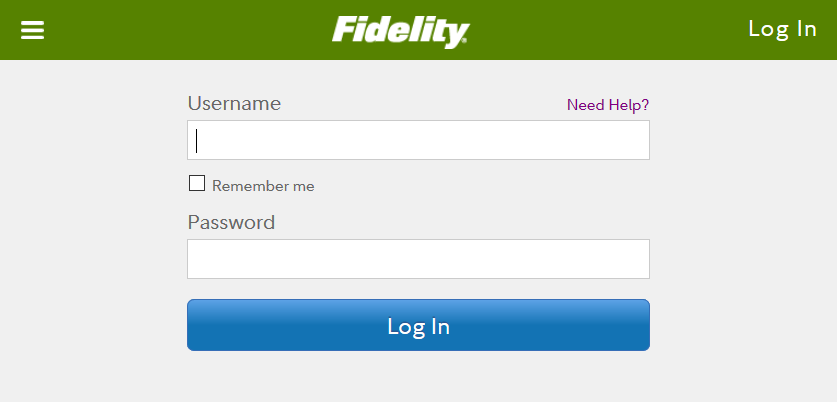Fidelity Login: Welcome to our guide on Fidelity Investments, a leading financial services corporation. Accessing your account online is crucial for managing investments efficiently.
This article will provide step-by-step instructions on the Fidelity login process, ensuring you can easily access your account to monitor and manage your financial assets effectively.
Preparing to Log In to Your Fidelity Account
Logging in to your Fidelity account should be straightforward and secure. Before you proceed, ensure you have the necessary credentials at hand and follow our tips to keep your account safe.
List of Necessary Credentials
To access your Fidelity account online, you will need the following:
- Username: Your unique identifier set during the account creation process.
- Password: Your private password. Remember, it should be strong and unique to protect your account.
- Security Questions: Be prepared to answer security questions, especially when logging in from an unrecognized device or location.
- Two-Factor Authentication Code: If you have enabled two-factor authentication, have your phone or authentication app ready to receive or generate a one-time code.
Tips for Ensuring Your Account Details Remain Secure
- Use Strong Passwords: Create passwords that use a mix of letters, numbers, and special characters. Avoid common words and phrases to prevent brute force attacks.
- Enable Two-Factor Authentication (2FA): Adding an extra layer of security helps safeguard your account even if your password is compromised.
- Regularly Update Your Password: Change your password periodically and avoid reusing passwords across different sites.
- Secure Your Devices: Ensure that any device you use to log in is secured with a password or biometric lock, and keep your operating system and applications updated to protect against vulnerabilities.
- Monitor Account Activity: Regularly check your account statements and transaction history for any unauthorized or suspicious activity. Report any discrepancies immediately.
- Beware of Phishing Attempts: Be cautious of emails or messages that ask for your credentials. Fidelity will never ask for your password or security codes via email.
By preparing your login credentials and adhering to these security practices, you can ensure a safe and seamless experience with your Fidelity account.
Step-by-Step Guide to Fidelity Login
Navigating the login process at Fidelity.com is straightforward whether you’re using a web browser or the Fidelity app. Follow these simple steps to securely access your account.
For Web Users
1. Visit the Official Website: Open your preferred web browser and go to www.fidelity.com.

2. Access the Login Page: Click on the ‘Log In’ button usually located at the top right corner of the homepage.
3. Enter Your Credentials: Type in your username and password in the provided fields.
4. Secure Your Login: Optionally, you can enable additional security features under the login box.
5. Complete the Login: Click ‘Log In’ to access your Fidelity account.
For App Users
1. Download the App: Install the Fidelity app from your device’s app store (available on iOS and Android).
2. Open the App: Tap on the app icon to open it.
3. Enter Login Information: Input your username and password.
4. Enhance Security: Opt for biometric login if your device supports it, for added security.
5. Access Your Account: Tap ‘Log In’ to enter your account.
Importance of Reviewing Terms Before Agreeing
Understanding the terms and conditions of any financial service is crucial. Here’s why:
1. Awareness of Rights and Obligations: Knowing the terms helps you understand what you’re entitled to and what is expected of you.
2. Avoiding Surprises: Familiarizing yourself with the account fees, penalties, and other crucial details prevents unexpected issues.
3. Informed Decisions: Reviewing the terms allows you to make educated decisions about using and managing your investments.
However, always take a moment to read through the terms thoroughly before agreeing to ensure that you are making the best choices for your financial health.
Managing Your Fidelity Account Once Logged In
Once you have successfully logged into your Fidelity account, a suite of management features becomes accessible, designed to enhance your investment experience and streamline account maintenance. Here’s how you can make the most of your account:
Overview of Account Management Features
Your Fidelity account dashboard is the command center for all your investment needs. Key features include:
- Investment Management: Easily buy, sell, or adjust your investments across stocks, bonds, mutual funds, and other assets. Utilize tools for portfolio analysis to align with your financial goals.
- Account Updates: Update personal details such as contact information, banking details, and beneficiary designations to ensure all account information is current.
- Financial Planning Tools: Access resources and calculators that help you plan for retirement, college savings, and other financial goals.
- Alerts and Notifications: Set up customized alerts for account activity, trade executions, or market events to stay informed without constant monitoring.
- Statements and Records: View and download monthly statements, tax documents, and transaction records for personal record-keeping or tax purposes.
Setting Up Account Preferences
Customizing your account settings can enhance your navigation and interaction with your Fidelity account, making your financial management more efficient:
- Login Preferences: Secure your account by updating your login credentials and activating features like two-factor authentication.
- Communication Preferences: Choose how you receive notifications from Fidelity—whether through email, text, or postal mail—based on your convenience and accessibility needs.
- Interface Customization: Adjust the layout of your dashboard and the visibility of certain tools to match your personal preferences and the frequency of use.
- Privacy Settings: Manage the visibility of your account details and control how much information is shared with third-party services.
- Investment Alerts: Tailor alert settings to notify you about specific account thresholds or market movements, helping you make timely investment decisions.
By effectively managing your Fidelity account and customizing its settings, you can ensure a more tailored and efficient investment experience, keeping you aligned with your financial objectives.
Enhancing Security for Your Fidelity Login
Securing your financial information is paramount, especially when managing your investments through platforms like Fidelity. Here are crucial steps to enhance the security of your Fidelity account.
Setting Up Two-Factor Authentication (2FA)
Importance of 2FA:
Two-Factor Authentication (2FA) adds an extra layer of security to your account login process, ensuring that access is granted only after presenting two distinct forms of verification. This significantly reduces the risk of unauthorized access, even if your password is compromised. The benefits of 2FA include:
- Enhanced Security: By requiring a second form of identification, 2FA makes it much harder for potential intruders to gain access to your account.
- Reduced Fraud Risk: 2FA provides a safeguard against identity theft and fraudulent transactions, protecting your assets.
- Increased Peace of Mind: Knowing that your account has an added layer of protection can give you greater confidence when managing your investments.
How to Enable 2FA:
- Login to Your Account: Start by logging into your Fidelity account.
- Navigate to Security Settings: Go to the ‘Profile’ section and select ‘Security Settings.’
- Activate 2FA: Find the option for Two-Factor Authentication and click ‘Enable.’ You may be asked to verify your phone number or email address.
- Follow Instructions: Complete the setup by following the on-screen instructions, which typically involve verifying a code sent to your phone or email.
Regularly Updating Your Password
Best Practices for Password Management and Security:
Regularly updating your password is a critical step in maintaining the security of your online accounts. Here are some best practices for effective password management:
- Complexity: Use passwords that are at least 12 characters long, incorporating a mix of letters, numbers, and symbols to increase complexity.
- Uniqueness: Avoid using the same password across multiple sites. Unique passwords for each account ensure that a breach on one site does not compromise another.
- Regular Updates: Change your passwords periodically, ideally every three to six months, to minimize the risk of unauthorized access.
- Use Password Managers: Consider using a reputable password manager to generate and store complex passwords. This not only enhances security but also simplifies the management of multiple accounts.
By implementing these security measures, you can significantly bolster the safety of your Fidelity login, ensuring that your financial assets are well-protected against potential cyber threats.
FAQs about Fidelity Login
1. How do I log in to my Fidelity account?
To log in to your Fidelity account, visit the Fidelity homepage and click on the ‘Log In’ button located at the top right corner of the page. Enter your username and password in the provided fields, and then click ‘Submit’ to access your account.
2. What should I do if I forget my Fidelity login password?
If you forget your password, click on the ‘Forgot Password?’ link on the login page. You will be prompted to enter your username and follow the instructions to reset your password via email or text message verification.
3. Can I access my Fidelity account on my mobile device?
Yes, you can access your Fidelity account on your mobile device. Download the Fidelity mobile app from the App Store or Google Play. Once installed, you can log in with your usual username and password to manage your investments on the go.
4. Is there a way to enhance the security of my Fidelity login?
To enhance the security of your Fidelity login, enable two-factor authentication (2FA) in your account settings. This feature adds an extra layer of security by requiring a second form of verification in addition to your password.
5. What do I do if I encounter problems logging into my Fidelity account?
If you experience issues logging into your account, check your internet connection and ensure that you are using the correct login credentials. If the problem persists, contact Fidelity customer support for assistance.
Conclusion
In this guide, we’ve walked you through the essential steps required to log in to your Fidelity account. From ensuring your device’s security settings are appropriate to navigating the login page and troubleshooting common issues, we’ve covered all you need to know for a seamless access experience.
Remember, maintaining the security of your login credentials is crucial. Be sure to follow these steps carefully to safeguard your financial information and gain hassle-free access to your account.
Ready to manage your investments with confidence? Follow the guidelines we’ve outlined, and you’re all set to take control of your Fidelity account today.
References
For further reading and to validate the information provided on Fidelity login processes, the following resources are highly recommended:
- Fidelity Investments Official Website – Access comprehensive details directly from the official source to ensure accuracy and up-to-date information. Visit Fidelity Investments.
- Investopedia on Fidelity Investments – A trusted resource for finance-related topics, Investopedia offers in-depth articles that cover various aspects of managing accounts with Fidelity. Check out their guide here.
- The Balance on Online Brokerage Accounts – For comparisons and broader context on how Fidelity stands against other brokerage accounts, The Balance provides clear, expert-reviewed content. Read more at The Balance.
Each of these resources will help users better understand the nuances of managing their investments through Fidelity and ensure they are making the most informed decisions possible.

